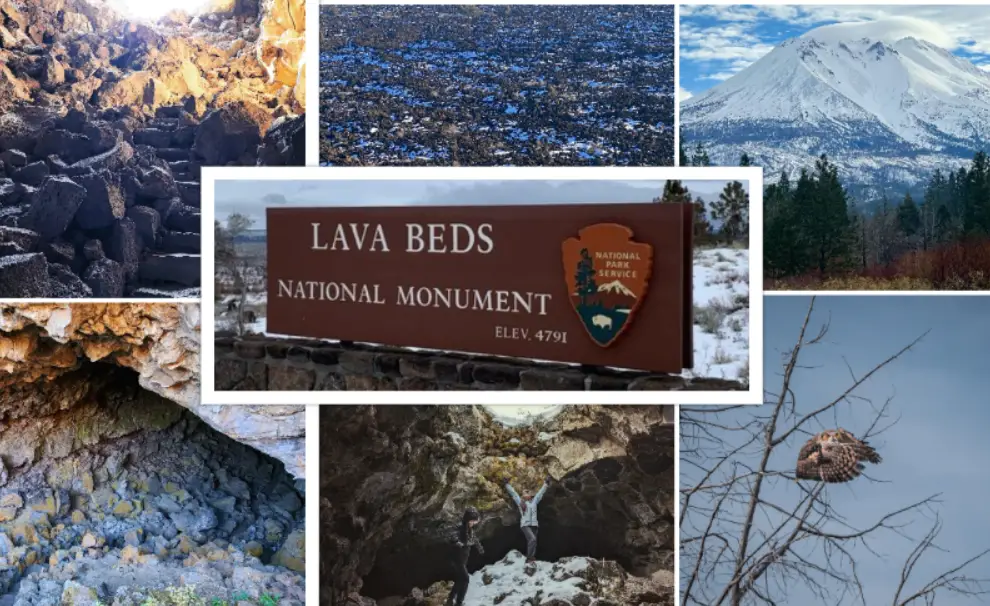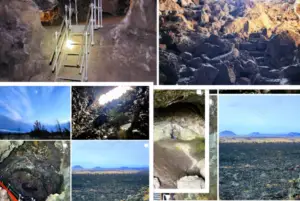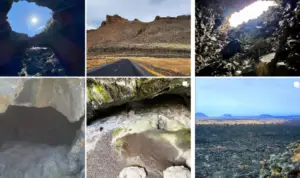Lava Beds National Monument : Interesting Facts, History & Travel Guide

- By
- Aparna Patel
- |
- 11 Apr, 2023
- |

Lava Beds National Monument is a unique and fascinating destination located in northeastern California. Known for its rugged volcanic landscape, extensive network of lava tube caves, and rich cultural history, Lava Beds National Monument offers a wide range of activities and experiences for visitors.
In this travel guide, we will explore the history, geology, and natural wonders of this incredible park, as well as provide tips for planning your visit, including where to camp, what to do, and what to see.
Join us as we delve into the fascinating world of Lava Beds National Monument and discover why it is one of California’s hidden gems.
Table of Contents
Interesting facts about Lava Beds National Monument
- Lava Beds National Monument is located in northern California, near the town of Tulelake. It covers an area of over 46,000 acres.
- The monument features more than 700 lava tube caves, which were formed by volcanic activity thousands of years ago.
- The park is home to a wide variety of plant and animal species, including bald eagles, pronghorn antelopes, and sagebrush.
- The caves at Lava Beds National Monument are some of the largest and most accessible in the world, making it a popular destination for caving enthusiasts.
- The park is also rich in Native American history, with more than 700 known archeological sites dating back to the Modoc people who lived in the area for thousands of years.
- One of the most significant events in the park’s history was the Modoc War, which took place in 1872-1873. The war was fought between the Modoc people and the U.S. Army, and it resulted in the capture and execution of several Modoc leaders.
- In addition to caving, other popular activities at Lava Beds National Monument include hiking, birdwatching, and stargazing. The park is known for its clear skies and lack of light pollution.
- The monument was established in 1925, and it was designated a National Monument in 1926. It is managed by the National Park Service.
How was Lava Beds National Monument formed?
Lava Beds National Monument was formed by volcanic activity that occurred over thousands of years. The area was part of a larger volcanic field that formed as a result of the movement of tectonic plates. The volcanic activity produced large amounts of basaltic lava, which flowed across the landscape and cooled to form the rugged terrain that is visible today.
The lava flows also created lava tube caves, which formed when the outer layers of lava cooled and hardened while the molten lava inside continued to flow, leaving behind a hollow space. These caves range in size from small crawl spaces to large chambers and tunnels that are hundreds of feet long.
Over time, erosion and weathering have shaped the landscape, creating deep canyons, cliffs, and spires. The unique geology and diverse habitats of Lava Beds National Monument provide a home for a variety of plant and animal species, many of which are adapted to the harsh volcanic environment.
How big is Lava Beds National Monument?
Lava Beds National Monument is located in northeastern California and covers an area of 46,692 acres (189.12 square kilometers). It is known for its unique geological features, including volcanic fields, lava tube caves, and cinder cones.
The monument also contains significant cultural and historical sites, including rock art and Native American artifacts. It was established as a national monument in 1925 and is managed by the National Park Service.
Information & History of Lava Beds National Monument
Lava Beds National Monument is a protected area located in northeastern California, near the town of Tulelake. It is known for its unique geological features, including more than 700 lava tube caves, as well as its rich Native American history.
The volcanic activity that formed Lava Beds National Monument occurred approximately 30,000 to 40,000 years ago. The park’s lava flows come from two shield volcanoes, the Mammoth Crater and the Medicine Lake Volcano, which are both located in the nearby area.
The area was first inhabited by Native American peoples around 11,000 years ago. The Modoc people lived in the region for thousands of years, adapting to the harsh volcanic landscape by developing a hunting and gathering way of life.
In the mid-19th century, white settlers began moving into the area, and tensions between them and the Modoc people grew. This eventually led to the Modoc War of 1872-1873, during which a group of Modoc warriors led by Captain Jack held off the U.S. Army for several months in a series of battles before eventually being defeated. Some of the battles took place in the park’s lava tube caves, which were used as natural fortifications.
In 1907, President Theodore Roosevelt set aside the area as the Lava Beds National Monument, and it was officially established in 1925. The park was created to preserve the unique geological features of the area, as well as to protect its natural and cultural resources.
Read More:
- Katahdin Woods and Waters National Monument : Interesting Facts, History & Travel Guide
- Kasha-Katuwe Tent Rocks : Interesting Facts, History & Travel Guide
- Utah – Jurassic National Monument : Interesting Facts, History & Travel Guide
- John Day Fossil Beds : Interesting Facts, History & Travel Guide
- Jewel Cave National Monument : Interesting Facts, History & Travel Guide
Today, Lava Beds National Monument is managed by the National Park Service and offers visitors the opportunity to explore its many caves and learn about its fascinating history. The park also provides a habitat for a wide variety of plant and animal species, and is an important site for scientific research.
Travel Guide for Lava Beds National Monument
If you’re planning a trip to Lava Beds National Monument, here’s a travel guide to help you make the most of your visit:
- Getting There: The park is located in northeastern California, about 45 miles southeast of Klamath Falls, Oregon. The nearest major airport is in Medford, Oregon, which is about 100 miles away. If you’re driving, the park can be accessed from Highway 139 or from Highway 299.
- Entrance Fee: There is a fee to enter the park, which is $30 per vehicle, $25 per motorcycle, and $15 for individuals on foot or bicycle. The fee is valid for seven days.
- Visitor Center: The park’s visitor center is a great place to start your visit. Here, you can learn about the park’s history and geology, as well as pick up maps and trail guides. The visitor center also has a bookstore and a small museum.
- Caving: Lava Beds National Monument is known for its many lava tube caves, and exploring them is one of the park’s main attractions. Some of the caves are easy to navigate and require no special equipment, while others are more challenging and may require headlamps or other gear. Check with the park rangers for recommendations based on your experience level.
- Hiking: The park has more than 20 miles of hiking trails, ranging from easy walks to more challenging treks. Some of the park’s most popular trails include the Mushpot Cave Trail, which offers views of several different types of lava formations, and the Symbol Bridge Trail, which features a natural stone bridge.
- Camping: The park has two campgrounds, each with its own unique features. The Indian Well Campground is located near the visitor center and offers sites for both tents and RVs, as well as access to a shower and laundry facilities. The more primitive camping option is at the backcountry campsites, which require a permit and a moderate hike.
- Wildlife Viewing: Lava Beds National Monument is home to a wide variety of wildlife, including pronghorn antelope, deer, coyotes, and many species of birds. Birdwatching is particularly popular, with the park’s clear skies and lack of light pollution making it an excellent spot for stargazing as well.
- Ranger Programs: The park offers a variety of ranger-led programs, including cave tours, hikes, and evening programs. Check with the park rangers or the visitor center for schedules and availability.
Lava Beds National Monument camping
Lava Beds National Monument offers several camping options for visitors. There are two developed campgrounds within the monument: the Indian Well Campground and the Atsukwi Campground. Both campgrounds have campsites with picnic tables, fire rings, and access to restrooms and water. The Indian Well Campground has 43 sites, while the Atsukwi Campground has 8 sites. These campgrounds are open year-round and are available on a first-come, first-served basis.
In addition to the developed campgrounds, there are also several backcountry camping options available in Lava Beds National Monument. Visitors can obtain a free backcountry permit from the visitor center and choose from several designated backcountry campsites. These campsites are primitive and do not have amenities like picnic tables or fire rings, so visitors must pack in and pack out all their own supplies.
Finally, Lava Beds National Monument also offers group camping options for organized groups of 10 or more people. The group campsites are located at the Indian Well Campground and can accommodate up to 25 people per site. Reservations are required for group camping and can be made by calling the park.
Lava Beds National Monument is a unique and fascinating destination that offers something for everyone. Whether you’re interested in history, geology, or outdoor recreation, this park is definitely worth a visit.
Know More About USA
- Ironwood Forest National Monument : Interesting Facts, History & Travel Guide
- Hovenweep National Monument : Interesting Facts, History & Travel Guide
- Hohokam Pima National Monument : Interesting Facts, History & Travel Guide
- Harriet Tubman Underground Railroad National Monument : Interesting Facts, History & Travel Guide
Search Posts
Latest posts
-
5 Mar, 2024
How to avoid drinking vodka?
-
4 Mar, 2024
Can I accidentally miss the in-flight food?
-
4 Mar, 2024
How to make dining alone less awkward?
-
4 Mar, 2024
How can I do a "broad" search for flights?
Popular posts
-
5 Mar, 2024
Why prohibit engine braking?
